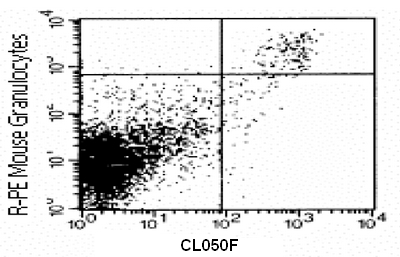Neutrophils Rat Monoclonal Antibody [Clone ID: 7/4]
Specifications
| Product Data | |
| Clone Name | 7/4 |
| Applications | FC, IHC |
| Recommended Dilution | Flow Cytometry. |
| Reactivities | Mouse |
| Host | Rat |
| Isotype | IgG2a |
| Clonality | Monoclonal |
| Immunogen | Cultured bone marrow cells. |
| Specificity | This antibody is specific for detecting Mouse Neutrophils. Strains reported to be Positive for the 7/4 clone are: AKR, C57BL/6, C57BL/10,C58, DBA/2, MF1, NZB, NZW, SJL, Swiss (PO) and 129J. Strains reported to be Negative/Weak for the 7/4 clone are: A2G, A/Sn, ASW, BALB/c, C3H/HEH and CBA.T6T6. Actual results of Flow Cytometric analysis Mouse strain: C57BL/6 Cell Source: Peripheral Blood Leukocytes Cell Concentration: 1x10e6 cells per test Antibody concentration: 1.0 µg/10e6 cells Isotypic Control: FITC Rat IgG2a Percentage of cells stained above control: 2.46% |
| Formulation | PBS Label: FITC State: Liquid purified Ig fraction. Stabilizer: EIA grade BSA as a stabilizing protein to bring total protein concentration to 4-5 mg/ml Preservative: 0.09% Sodium Azide |
| Concentration | 0.1 mg/ml |
| Conjugation | FITC |
| Background | Neutrophils constitute the principal cells of acute inflammation.Their entrance is stimulated by chemotactic factors secreted from injured cells, resident tissue macrophages, and complement activation. Neutrophils can also be activated by Fc region of antibodies, and by T-cell derived cytokines. A very potent chemotactic factor for neutrophils is C5a, a peptide product of complement activation. Neutrophils contain abundant cytoplasmic granules, which contain toxic proteins. (clinical correlete:type III, roitt) They are short lived cells. They engulf microorganisms, destroy it, but die quickly thereafter. Neutrophils are activated by antibodies, complement and cytokines. |
| Note | Protocol: FLOW CYTOMETRY ANALYSIS Method: 1. Prepare a cell suspension in media A. For cell preparations, deplete the red blood cell population using a NH4Cl lysing buffer. 2. Wash 2 times. 3. Resuspend the cells to a concentration of 2x107 cells/ml in media A. Add 50 μl of this suspension to each tube (each tube will then contain 1 x 106 cells, representing 1 test). 4. To each tube, add ~1.0 μg of CL050F per 106 cells. 5. Vortex the tubes to ensure thorough mixing of antibody and cells. 6. Incubate the tubes for 30 minutes at 4°C. (It is recommended that the tubes are protected from light, since most fluorochromes are light sensitive.) 7. Wash 2 times at 4°C. 8. Resuspend the cell pellet in 50 μl ice cold media B. 9. Transfer to suitable tubes for flow cytometric analysis containing 15 μl of propidium iodide at 0.5 mg/ml in PBS. This stains dead cells by intercalating in DNA. Media: A. Phosphate buffered saline (pH 7.2) + 5% normal serum of host species + sodium azide (100 μl of 2M sodium azide in 100 mls). B. Phosphate buffered saline (pH 7.2) + 0.5% Bovine serum albumin + sodium azide (100 μl of 2M sodium azide in 100 mls). |
| Reference Data | |
Documents
| Product Manuals |
| FAQs |
| SDS |
{0} Product Review(s)
0 Product Review(s)
Submit review
Be the first one to submit a review
Product Citations
*Delivery time may vary from web posted schedule. Occasional delays may occur due to unforeseen
complexities in the preparation of your product. International customers may expect an additional 1-2 weeks
in shipping.






























































































































































































































































 Germany
Germany
 Japan
Japan
 United Kingdom
United Kingdom
 China
China



